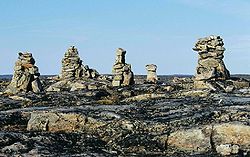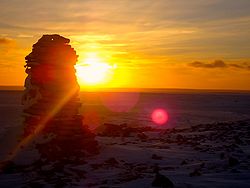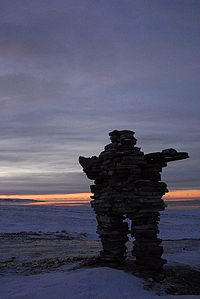Difference between revisions of "Inuksuk" - New World Encyclopedia
| Line 20: | Line 20: | ||
Inuksuit are markers, beacons, or [[cairn]]s built of dry stacked stones, driftwood or bones. They generally range in size from {{convert|.5|m}} {{convert|2|m}} in height and up to {{convert|2|m}} in width.<ref name=Heyes> Scott Heyes, [http://www.erudit.org/revue/etudinuit/2002/v26/n2/007648ar.html Protecting the authenticity and integrity of inuksuit within the arctic milieu] ''Études/Inuit/Studies'' 26(2) (2002):133-156. Retrieved September 30, 2013.</ref> According to ''[[Guinness World Records]]'', the tallest inuksuk is in [[Schomberg, Ontario]], Canada. Built in 2007, it is {{convert|11.377|m}} tall.<ref name=guinness>[http://www.guinnessworldrecords.com/world-records/5000/tallest-inukshuk Tallest Inukshuk] ''Guinness World Records''. Retrieved October 1, 2013.</ref> | Inuksuit are markers, beacons, or [[cairn]]s built of dry stacked stones, driftwood or bones. They generally range in size from {{convert|.5|m}} {{convert|2|m}} in height and up to {{convert|2|m}} in width.<ref name=Heyes> Scott Heyes, [http://www.erudit.org/revue/etudinuit/2002/v26/n2/007648ar.html Protecting the authenticity and integrity of inuksuit within the arctic milieu] ''Études/Inuit/Studies'' 26(2) (2002):133-156. Retrieved September 30, 2013.</ref> According to ''[[Guinness World Records]]'', the tallest inuksuk is in [[Schomberg, Ontario]], Canada. Built in 2007, it is {{convert|11.377|m}} tall.<ref name=guinness>[http://www.guinnessworldrecords.com/world-records/5000/tallest-inukshuk Tallest Inukshuk] ''Guinness World Records''. Retrieved October 1, 2013.</ref> | ||
[[File:Inuksugalait Foxe-PI 2002-07-26.jpg|thumb|left|250 px|Inuksuit at the [[Foxe Peninsula]] ([[Baffin Island]]), Canada]] | [[File:Inuksugalait Foxe-PI 2002-07-26.jpg|thumb|left|250 px|Inuksuit at the [[Foxe Peninsula]] ([[Baffin Island]]), Canada]] | ||
| − | There are many styles of inuksuk, the most common built with stone placed upon stone. The structure may consist of a single upright stone, or a cairn-like structure created by stacking the stones on top of each other. Four general shapes of inuksuit can be found. The most elementary kind of inuksuit is the ''nalunaikkutaq'' ("deconfuser") that is made of a single upright stone. A second type consist of ''tikkuuti'', which are pointers. They may appear as a triangular-shaped rock lying flat on the ground or a line of rocks arranged in a straight line, with the largest rock at one end grading down to the smallest at the other end, indicating the direction to be taken. The third type is the ''inuksummarik'' or ''inuksukjuaq'', noted for its large size that allows it to be seen from a distance. Finally, there are inuksuit where an arrangement of stones at their base has been left as a message.<ref>Norman Hallendy, [http://www.thecanadianencyclopedia.com/articles/inuksuk-inukshuk Inuksuk] ''The Canadian Encyclopedia''. Retrieved September 30, 2013.</ref> | + | There are many styles of inuksuk, the most common built with stone placed upon stone. The structure may consist of a single upright stone, or a cairn-like structure created by stacking the stones on top of each other. Four general shapes of inuksuit can be found. The most elementary kind of inuksuit is the ''nalunaikkutaq'' ("deconfuser") that is made of a single upright stone. A second type consist of ''tikkuuti'', which are pointers. They may appear as a triangular-shaped rock lying flat on the ground or a line of rocks arranged in a straight line, with the largest rock at one end grading down to the smallest at the other end, indicating the direction to be taken. The third type is the ''inuksummarik'' or ''inuksukjuaq'', noted for its large size that allows it to be seen from a distance. Finally, there are inuksuit where an arrangement of stones at their base has been left as a message.<ref name=Hallendy>Norman Hallendy, [http://www.thecanadianencyclopedia.com/articles/inuksuk-inukshuk Inuksuk] ''The Canadian Encyclopedia''. Retrieved September 30, 2013.</ref> |
Inuksuit appear throughout the [[Arctic]], with several prominent forms along the shores and in the interior between [[Hudson Bay]] and Ungava Bay in Nunavik. Most hilltops near Inuit villages feature an inuksuk.<ref name=Heyes/> | Inuksuit appear throughout the [[Arctic]], with several prominent forms along the shores and in the interior between [[Hudson Bay]] and Ungava Bay in Nunavik. Most hilltops near Inuit villages feature an inuksuk.<ref name=Heyes/> | ||
| Line 30: | Line 30: | ||
An inuksuk could be used for navigation, as a point of reference, a marker for travel routes, fishing places, camps, hunting grounds, places of [[veneration]],<ref name=Gray>Charlotte Gray, ''The Museum Called Canada, 25 Rooms of Wonder'' (Random House of Canada, 2004, ISBN 978-0679312208).</ref> or to mark a food cache.<ref name=SimonFraser>[http://www.sfu.ca/aboriginalpeoples/inukshuk.html The Inuit Inukshuk] Simon Fraser University Office for Aboriginal Peoples. Retrieved September 30, 2013.</ref> The [[Inupiat]] in northern [[Alaska]] used inuksuit when hunting to assist in the herding of [[Reindeer|caribou]] into contained areas for slaughter. Hunters could also hide behind a larger inuksuk.<ref name=SimonFraser/> | An inuksuk could be used for navigation, as a point of reference, a marker for travel routes, fishing places, camps, hunting grounds, places of [[veneration]],<ref name=Gray>Charlotte Gray, ''The Museum Called Canada, 25 Rooms of Wonder'' (Random House of Canada, 2004, ISBN 978-0679312208).</ref> or to mark a food cache.<ref name=SimonFraser>[http://www.sfu.ca/aboriginalpeoples/inukshuk.html The Inuit Inukshuk] Simon Fraser University Office for Aboriginal Peoples. Retrieved September 30, 2013.</ref> The [[Inupiat]] in northern [[Alaska]] used inuksuit when hunting to assist in the herding of [[Reindeer|caribou]] into contained areas for slaughter. Hunters could also hide behind a larger inuksuk.<ref name=SimonFraser/> | ||
| + | |||
| + | The practical information conveyed by an inuksuk could be quite complex. The arrangement of stones could convey vital messages to a traveler about the depth of snow, the safety or danger of a crossing place, or where food and supplies were cached. They also mark good hunting or fishing grounds, and some have been been constructed to form a "window" through which a person can view distant inuksuit thus serving as navigational aids. Or they may simply indicate that the village is close by, a welcome sight to any traveler.<ref name=Hallendy> | ||
| + | |||
| + | In addition to such practical functions, other inuksuit have spiritual connotations. Some were constructed by [[shaman]]s, and were believed to contain spirits, either friendly or dangerous, or other types of spiritual power.<ref name=Hallendy> | ||
| + | |||
| + | Many Inuit today revere certain inuksuit because they were built by their ancestors. In this way they provide an important link to the past generations, keeping a connection with the culture and knowledge of those who survived the harsh life in the Arctic. | ||
==Modern usage== | ==Modern usage== | ||
Revision as of 19:19, 1 October 2013
An inuksuk (plural inuksuit) (from the Inuktitut: ᐃᓄᒃᓱᒃ, plural ᐃᓄᒃᓱᐃᑦ; alternatively inukshuk in English or inukhuk in Inuinnaqtun is a stone landmark or cairn built by humans, used by the Inuit, Inupiat, Kalaallit, Yupik, and other peoples of the Arctic region of North America. These structures are found from Alaska to Greenland, a region above the Arctic Circle that is dominated by the tundra biome and has areas with few natural landmarks.
| This article contains Canadian Aboriginal syllabic characters. Without proper rendering support, you may see question marks, boxes, or other symbols instead of syllabics. |
Name
The word inuksuk means "something which acts for or performs the function of a person." The word comes from the morphemes inuk ("person") and -suk ("ersatz" or "substitute") in the Inuit language, Inuktitut. The plural is inuksuit.[1]
The word is pronounced inutsuk in Nunavik and the southern part of Baffin Island. In many of the central Nunavut dialects, it has the etymologically related name inuksugaq (plural: inuksugait).
It is often alternatively written inukshuk in English or inukhuk in Inuinnaqtun[2] However, the Governments of Nanavut and Canada support the Inuit-preferred spelling inuksuk.
A structure similar to an inuksuk, but meant to represent a human figure, is called an inunnguaq (ᐃᓄᙳᐊᖅ, "imitation of a person," plural inunnguat), has become widely familiar to non-Inuit. However, it is not the most common type of inuksuk, and it is distinguished from the traditional inuksuit.[3]
Description
Inuksuit are markers, beacons, or cairns built of dry stacked stones, driftwood or bones. They generally range in size from .5 meters (1.6 ft) 2 meters (6.6 ft) in height and up to 2 meters (6.6 ft) in width.[4] According to Guinness World Records, the tallest inuksuk is in Schomberg, Ontario, Canada. Built in 2007, it is 11.377 meters (37.33 ft) tall.[5]

There are many styles of inuksuk, the most common built with stone placed upon stone. The structure may consist of a single upright stone, or a cairn-like structure created by stacking the stones on top of each other. Four general shapes of inuksuit can be found. The most elementary kind of inuksuit is the nalunaikkutaq ("deconfuser") that is made of a single upright stone. A second type consist of tikkuuti, which are pointers. They may appear as a triangular-shaped rock lying flat on the ground or a line of rocks arranged in a straight line, with the largest rock at one end grading down to the smallest at the other end, indicating the direction to be taken. The third type is the inuksummarik or inuksukjuaq, noted for its large size that allows it to be seen from a distance. Finally, there are inuksuit where an arrangement of stones at their base has been left as a message.[6]
Inuksuit appear throughout the Arctic, with several prominent forms along the shores and in the interior between Hudson Bay and Ungava Bay in Nunavik. Most hilltops near Inuit villages feature an inuksuk.[4]
There are unusual concentrations of between 100-200 inuksuit at Inuksualait (Enukso Point), at Foxe Peninsula on Baffin Island. The site was designated a National Historic Site of Canada in 1969.[7]
Historical usage
Varying in shape and size, the inuksuit have roots going back thousands of years and served an important role in the Inuit culture. Many conveyed messages, while others were used as aids in hunting. Still others had a spiritual meaning.
An inuksuk could be used for navigation, as a point of reference, a marker for travel routes, fishing places, camps, hunting grounds, places of veneration,[8] or to mark a food cache.[9] The Inupiat in northern Alaska used inuksuit when hunting to assist in the herding of caribou into contained areas for slaughter. Hunters could also hide behind a larger inuksuk.[9]
The practical information conveyed by an inuksuk could be quite complex. The arrangement of stones could convey vital messages to a traveler about the depth of snow, the safety or danger of a crossing place, or where food and supplies were cached. They also mark good hunting or fishing grounds, and some have been been constructed to form a "window" through which a person can view distant inuksuit thus serving as navigational aids. Or they may simply indicate that the village is close by, a welcome sight to any traveler.Cite error: Closing </ref> missing for <ref> tag
Officials in various wilderness parks throughout Canada routinely dismantle inuksuit constructed by hikers and campers, for fear that they could misdirect park visitors from the cairns and other markers that indicate hiking trails.
A large number of inuksuit have been built in some areas along the Trans-Canada Highway, including Northern Ontario. While they do not carry the same types of meaning as the traditional Inuit inuksuit, in fact some of them appear to have been created “out of intent to be silly,” many have meaning nonetheless. For example, one person who had built two inuksuit along the route attributed his action to having had a "fill the dreams moment where I needed to stop and do it" while driving home from a family funeral.[10]
Notes
- ↑ Alex Spalding, Inuktitut: A Multi-dialectal Outline Dictionary (Nunavut Arctic College, 1998, ISBN 978-1896204291).
- ↑ Gwen Angulalik (ed.), Inuinnaqtun-English Dictionary (Inhabit Media, 2012).
- ↑ Peter Irniq, The Ancestral Inuksuk Ingilgaat Inuksuit Naniiliqpita, Nunavut Tunngavik Inc., 2006. Retrieved September 30, 2013.
- ↑ 4.0 4.1 Scott Heyes, Protecting the authenticity and integrity of inuksuit within the arctic milieu Études/Inuit/Studies 26(2) (2002):133-156. Retrieved September 30, 2013.
- ↑ Tallest Inukshuk Guinness World Records. Retrieved October 1, 2013.
- ↑ Norman Hallendy, Inuksuk The Canadian Encyclopedia. Retrieved September 30, 2013.
- ↑ Inuksuk National Historic Site of Canada Canada's Historic Places. Retrieved September 30, 2013.
- ↑ Charlotte Gray, The Museum Called Canada, 25 Rooms of Wonder (Random House of Canada, 2004, ISBN 978-0679312208).
- ↑ 9.0 9.1 The Inuit Inukshuk Simon Fraser University Office for Aboriginal Peoples. Retrieved September 30, 2013.
- ↑ Jenny Jelen, "The Inukshukification of Highway 69". Northern Life, September 22, 2010. Retrieved October 1, 2013.
ReferencesISBN links support NWE through referral fees
- Angulalik, Gwen (ed.). Inuinnaqtun-English Dictionary. Inhabit Media, 2012. ASIN B00DZG5PI8
- Gray, Charlotte. The Museum Called Canada: 25 Rooms of Wonder. Random House of Canada, 2004. ISBN 978-0679312208
- Hallendy, Norman. Inuksuit: Silent Messengers of the Arctic. Douglas & McIntyre, 2001. ISBN 978-1550548747
- Hallendy, Norman. Tukiliit: The Stone People Who Live in the Wind. University of Alaska Press, 2009. ISBN 978-1602230576
- Niosi, Goody. Ken Kirkby: A Painter's Quest for Canada. Libros Libertad, 2009. ISBN 978-0981073576
- Spalding, Alex. Inuktitut: A Multi-dialectal Outline Dictionary. Nunavut Arctic College, 1998, ISBN 978-1896204291
External links
All links retrieved
- Arctic Inuit Art
- Inuksuk, Inunnguaq, Inuksuit
- Places of Power - essay and photographs of inuksuit
- Vancouver 2010 Olympic Winter Games Emblem
- Canadian Heritage Minute video about the inuksuk
Credits
New World Encyclopedia writers and editors rewrote and completed the Wikipedia article in accordance with New World Encyclopedia standards. This article abides by terms of the Creative Commons CC-by-sa 3.0 License (CC-by-sa), which may be used and disseminated with proper attribution. Credit is due under the terms of this license that can reference both the New World Encyclopedia contributors and the selfless volunteer contributors of the Wikimedia Foundation. To cite this article click here for a list of acceptable citing formats.The history of earlier contributions by wikipedians is accessible to researchers here:
The history of this article since it was imported to New World Encyclopedia:
Note: Some restrictions may apply to use of individual images which are separately licensed.


